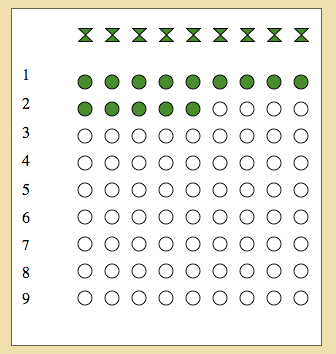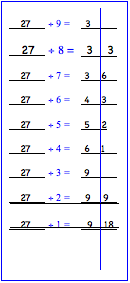|
- The unit division board
- 9 green skittles
- A box with 81 green beads
- Printed division slips
- Show the child the material and have him bring it to the table.
- Look at the board with the child. Show him all the places for the beads.
- Show him the numbers at the top of the boards and tell him that they are the dividend.
- Tell him the numbers on the side will be the answer.
- Write 27 ¸ 9 = on squared paper.
- Begin by telling the child the two rules: the answer cannot be larger than 9 and the remainder cannot be equal to or larger than the divisor.
- Place 27 green beads into the glass bowl.
- Ask the child how many times will we give 27 out. (9)
- Place 9 green skittles along the top of the board.
- Give each skittle a bead until there are no beads left.
See below for the equation in progress:
 |
 |
Table of division |
division |
remainder |
|
|
- Say, “27 ¸ 9 is 3”. Point to the 3 along the vertical side of the board.
- Have the child write in the answer to the equation.
- Have him replace the beads into the bowl.
- Ask the child how many beads we have in the bowl. (27)
- Tell him as you write the next part of the equation on the second line of paper, “27 ¸ 8 =”
- Have him do this equation as he had just done the last.
- Have him write the answer with the remainder.
- Read the whole equation with the child.
- Tell the child that there is something special about the remainder: “We can have a remainder as long as it is smaller than the dividend.”
- Repeat as above for 27 ¸ 6 =
- After the child has written the answer and the remainder check to see if the remainder is smaller than the dividend.
- Repeat in this way for the entire sheet of paper.
- When you reach 27 ¸ 2, your remainder will be bigger than the dividend. Point this out to the child and then cross out the entire equation because: “We can never have a remainder that is the same or bigger than the dividend.”

- Write 81 ¸ 9 =
- Have the child count 81 beads into the glass bowl and place nine skittles at the top of the board.
- Have the child do this equation as written above.
- Read the finished equation out loud with the child.
- Then write: 81 ¸ 8 =
- Have the child do this equation and write in the remainder.
- Look with the child at the remainder and notice that it is bigger than the dividend.
- Cross off the whole equation.
- Repeat for 81 ¸ 7 =
- Repeat for 81 ¸ 6 =
- Look at the last three crossed off equations and wonder out loud: “I wonder if the others will also have a remainder larger than the dividend?”
- The child should notice that the remainder gets bigger and bigger as the dividend gets smaller and smaller.
- Decide together that because of this pattern, only 81 ¸ 9 works.
- You can finish this presentation here.
On the same day or at a later date repeat this work for 80 ¸ 9 through 1, 79 ¸ 9 through 1, 78 ¸ 9 through 1, etc…
For the first few sets of work, clear the board after each equation.
Once the child understands that each equation is a new and different equation, you do not need to clear the board after each equation.
The child can work as shown in the presentation. Once the child
has done all the equations on all of the slips, re-read the equations. Underline in red the equations with no remainder. The child can then record all of the equations with no remainder on the squared paper.
To familiarize the child with the various ways in which numbers may be divided.
Division Chart 1
5 1/2 - 6 years
Share your experiences in the
| 
